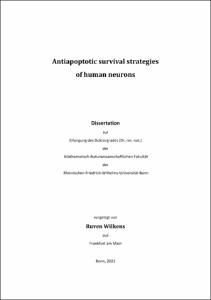Antiapoptotic survival strategies of human neurons

Antiapoptotic survival strategies of human neurons

| dc.contributor.advisor | Koch, Philipp | |
| dc.contributor.author | Wilkens, Ruven | |
| dc.date.accessioned | 2021-06-28T15:04:02Z | |
| dc.date.available | 2022-07-01T22:00:14Z | |
| dc.date.issued | 28.06.2021 | |
| dc.identifier.uri | https://hdl.handle.net/20.500.11811/9189 | |
| dc.description.abstract | Neurons of the central and peripheral nervous system are the key information processing and relay units within the human body. Since neurons are post-mitotic cells and neurogenesis in the adult human brain is very limited, neurons lost to injury or cellular stress cannot be replaced. Thus, neurons within mature neuronal networks of the brain have to be guarded by protective strategies to remain functional over the lifespan of an individual. Using human induced pluripotent stem cell (hiPSC)-derived forebrain neurons, this study aimed to analyze transcriptional changes during neuronal maturation and to identify possible regulatory differences between immature and mature neurons regarding their potential for long-term survival. In particular, neuronal maturation was accompanied by an increasing threshold for mitochondrial outer membrane permeabilization, the initial step of the intrinsic apoptosis pathway. In addition, mature neurons displayed a downregulation of the apoptotic proteins APAF-1 and Caspases-3, -7 and -9. We also observed an increased ubiquitination of the mitochondrial inhibitor of apoptosis protein (IAP) antagonist SMAC/DIABLO. Conversely, protein levels of XIAP, the major IAP, were strongly upregulated during the time course of neuronal maturation. These beneficial adaptations synergized to suppress the intrinsic apoptosis pathway endowing mature neurons with significantly higher survival competency than immature neurons when challenged with a wide range of different cellular insults. Approaches to further improve neuronal survival capabilities are highly desirable for the prevention of age-related neurodegeneration. Recently, genetic or pharmacological activation of the hexosamine biosynthetic pathway (HBP) have been reported to protect C. elegans and murine cells from tunicamycin (TM)-induced protein folding stress and toxic protein aggregation. The HBP integrates several metabolic pathways to synthesize the aminosugar uridine diphosphate N-acetylglucosamine (UDP-GlcNAc) which is a substrate for glycosylation reactions. Increased UDP-GlcNAc levels have been linked to a protective activation of the PERK branch of the integrated stress response (ISR). HBP activity can be increased by gain-of-function (gof) point mutations in the rate limiting enzyme GFAT-1 or by supplementation of N-acetylglucosamine (GlcNAc). Using CRISPR-Cas9 gene editing, we generated hiPSCs harboring the GFAT-1 G451E gof mutation to assess the related effects in human neural cells. We found genetic GFAT-1 gof to confer protection against TM-induced stress in NPCs and immature neurons but not in mature neurons which were inherently resistant. GlcNAc supplementation was only effective in NPCs but not in neurons. Corresponding Western blot experiments did not confirm an involvement of the PERK branch of the ISR and thus call into question the relevance of the previously proposed mechanism in human neural cells. Consequently, the protective potential of HBP activation beyond TM-resistance and the underlying mechanism warrant further investigation. | en |
| dc.language.iso | eng | |
| dc.rights | In Copyright | |
| dc.rights.uri | http://rightsstatements.org/vocab/InC/1.0/ | |
| dc.subject | Neurone | |
| dc.subject | Apoptose | |
| dc.subject | Reifung | |
| dc.subject | Differenzierung | |
| dc.subject | Stress | |
| dc.subject | neuron | |
| dc.subject | apoptosis | |
| dc.subject | maturation | |
| dc.subject | differentiation | |
| dc.subject.ddc | 570 Biowissenschaften, Biologie | |
| dc.title | Antiapoptotic survival strategies of human neurons | |
| dc.type | Dissertation oder Habilitation | |
| dc.publisher.name | Universitäts- und Landesbibliothek Bonn | |
| dc.publisher.location | Bonn | |
| dc.rights.accessRights | openAccess | |
| dc.identifier.urn | https://nbn-resolving.org/urn:nbn:de:hbz:5-62862 | |
| ulbbn.pubtype | Erstveröffentlichung | |
| ulbbnediss.affiliation.name | Rheinische Friedrich-Wilhelms-Universität Bonn | |
| ulbbnediss.affiliation.location | Bonn | |
| ulbbnediss.thesis.level | Dissertation | |
| ulbbnediss.dissID | 6286 | |
| ulbbnediss.date.accepted | 16.06.2021 | |
| ulbbnediss.institute | Medizinische Fakultät / Institute : Institut für Rekonstruktive Neurobiologie (IRN) | |
| ulbbnediss.fakultaet | Mathematisch-Naturwissenschaftliche Fakultät | |
| dc.contributor.coReferee | Höhfeld, Jörg | |
| ulbbnediss.date.embargoEndDate | 01.07.2022 | |
| ulbbnediss.contributor.gnd | 1238935907 |
Files in this item
This item appears in the following Collection(s)
-
E-Dissertationen (4337)




